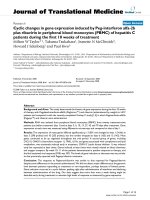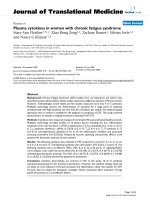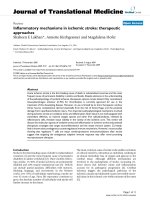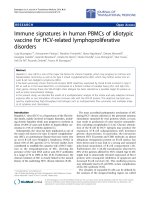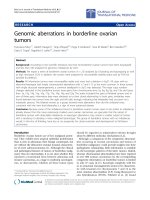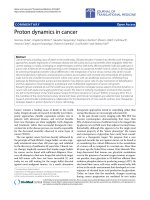báo cáo hóa học:" Shell structures in aluminum nanocontacts at elevated temperatures" docx
Bạn đang xem bản rút gọn của tài liệu. Xem và tải ngay bản đầy đủ của tài liệu tại đây (326.93 KB, 12 trang )
This Provisional PDF corresponds to the article as it appeared upon acceptance. Fully formatted
PDF and full text (HTML) versions will be made available soon.
Shell structures in aluminum nanocontacts at elevated temperatures
Nanoscale Research Letters 2012, 7:115 doi:10.1186/1556-276X-7-115
Jose L Costa-Kramer ()
Natalia Leon ()
Carlo Guerrero ()
Marisel Diaz ()
ISSN 1556-276X
Article type Nano Express
Submission date 19 August 2011
Acceptance date 10 February 2012
Publication date 10 February 2012
Article URL />This peer-reviewed article was published immediately upon acceptance. It can be downloaded,
printed and distributed freely for any purposes (see copyright notice below).
Articles in Nanoscale Research Letters are listed in PubMed and archived at PubMed Central.
For information about publishing your research in Nanoscale Research Letters go to
/>For information about other SpringerOpen publications go to
Nanoscale Research Letters
© 2012 Costa-Kramer et al. ; licensee Springer.
This is an open access article distributed under the terms of the Creative Commons Attribution License ( />which permits unrestricted use, distribution, and reproduction in any medium, provided the original work is properly cited.
Shell structures in aluminum nanocontacts at elevated temperatures
José Luis Costa-Krämer*
1
, Natalia León
2,3
, Carlo Guerrero
2
, and Marisel Díaz
2
1
IMM-Instituto de Microelectrónica de Madrid (CNM-CSIC), Isaac Newton 8, PTM, Tres
Cantos, Madrid, E-28760, Spain
2
Centro de Física, Instituto Venezolano de Investigaciones Científicas (IVIC), Apartado
Postal 20632, Caracas, 1020A, Venezuela
3
Departamento de Mecánica, Universidad Simón Bolívar, Valle de Sartenejas, Apartado
Postal 89000, Baruta, Caracas, 1020A, Venezuela
Corresponding author:
Email addresses:
JLC-K:
NL:
CG:
MD:
Abstract
Aluminum nanocontact conductance histograms are studied experimentally from room
temperature up to near the bulk melting point. The dominant stable configurations for this
metal show a very early crossover from shell structures at low wire diameters to ionic
subshell structures at larger diameters. At these larger radii, the favorable structures are
temperature-independent and consistent with those expected for ionic subshell (faceted)
formations in face-centered cubic geometries. When approaching the bulk melting
temperature, these local stability structures become less pronounced as shown by the
vanishing conductance histogram peak structure.
Introduction
The study of shell structures in metallic nanowires has been a topic of increasing interest
during the last few years [1-13]. These shell structures are a close analog to shell structures
observed for metal clusters [14, 15]. For alkali metals, it has been observed that the stability
of the nanowires formed is influenced by electronic shell filling effects associated with
atomic arrangements that produce the closing of electronic shells [1-3]. However, for Na
and K at larger diameters, a crossover is found from which shell closings correspond to
crystalline facet completion with an additional atomic layer [2, 3]. These shell and subshell
effects in nanowires manifest as stability peaks in the conductance histograms as the
conductance depends on the wire's minimum cross section. In previous works on alkali
metals [1-3], the conductance is measured at about one-third of the metal melting
temperature as all the shell effect oscillations were observable at elevated temperatures.
However, broad-peak precursors of the electronic shell effect are observed at 4.2 K [3]. In a
previous work [4], clear evidence was presented of an atomic shell structure in gold
nanocontacts formed at room temperature (far from the Au bulk melting point 1,340 K).
These results confirmed conductance histograms as a powerful tool to study stable
configurations of nanostructures.
In this work, conductance histograms for aluminum nanowires are presented at different
2
temperatures, from room temperature [RT] up to near the melting point of the bulk. This
explores the influence of temperature on the stable configurations seen by the different
shell and subshell structures in these metal nanocontacts. This extends a previous study
performed by a different technique at RT [16].
Experiments
Figure 1 shows the experimental setup. A custom-made scanning tunneling microscope is
used to form and break contacts between two Al polycrystalline wires (99.95% purity).
This is achieved by applying a voltage ramp, ±100 V at 1 Hz, to an internal piezoelectric
actuator which has glued one of the electrodes (Al wire). An external piezoelectric actuator
holds, approaches, and separates controllably another Al wire glued to an inertial mobile. A
tungsten heater coil tightly surrounds both electrodes. This heater is degasified before the
experiments and used (1) to bake the electrodes prior to the experiments and (2) to maintain
the electrodes at constant temperature during the nanowire elongation experiments. The
setup is held in an ultrahigh vacuum chamber with a base pressure in the 10
−9
to 10
−10
Torr
range. In addition, to ensure the maximum cleanliness of the Al contact area, every few
minutes, a capacitor was charged with the electrodes separated and subsequently discharged
across the electrodes by a controlled approach. This sublimates the Al contact area and
creates two fresh surface contact areas. This discharge was visually observed from outside
the chamber as a small spark in the contact area. Between cleaning procedures, series of
200 consecutive curves, lasting a few minutes, were acquired. This number was chosen
because the dynamics of the contact formation/breakage at constant experimental
conditions started degrading after 300 to 400 curves, probably signaling some local
degradation/oxidation of the contact area. The current in the nanowire at a constant bias
voltage is measured using a current-voltage converter with a 10
5
gain and an approximately
3-µs rise time. The current signal, triggered properly, is digitized and acquired with a
TDS220 digital oscilloscope (Tektronix, Inc., Madrid, Spain) and transferred to a personal
computer through a GPIB where the conductance is calculated and displayed and the
cumulative histogram of thousands of consecutive experiments is built.
Results and discussion
Figure 2 shows the Al nanowire conductance histograms recorded at a 20-mV bias voltage
for four different temperatures below the Al bulk melting point (930 K). The temperatures
reported are estimations based on the oven temperature, measured with a pyrometer, and
readjusted to match the observed melting of aluminum and indium wires of the same
diameter placed at the electrode positions. Every histogram has been built with more than
1,000 individual conductance traces and normalized by their total number. These
histograms allow to explore a region with g = G/G
0
< 43 (where G
0
= 2e
2
/h is the quantum
of conductance). In Figure 3, we show the histograms obtained with a 90-mV bias voltage.
These histograms allow exploring the low conductance region (g < 7) with better
resolution. By inspecting both figures, it is clear that the temperature has a dramatic effect
on the histograms. At RT, it is clear that the presence of well-defined peaks close to
quantum units (g at approximately 1, 2, 3). The peaks at g at approximately 2 and 3 have
approximately the same intensity, as has been previously observed experimentally and
supported by molecular dynamics simulations [17]. As the temperature increases, lower
conductance peaks decrease in favor of broader and higher conductance structures. In fact,
at 500 K, the peak at g at approximately 1 has one-third of the intensity of that at 300 K
3
while the peak at g at approximately 3 is more intense than that at g at approximately 2 (see
Figure 3). At 600 K, the peak at g at approximately 1 has already disappeared. It is due to
increasing thermal instabilities. In addition, at high conductance values, the high
conductance region of the histogram increases in comparison to the 300-K case. This trend
is similar to that found in alkali metals [1-3] and in molecular dynamics simulations of Al
[18]. It is the result of the increased mobility of the atoms that allows the system to explore
many atomic configurations in order to efficiently find a suitable local energy minimum.
The presence of shell structures is revealed by a linear relationship between the wire radius,
R, and the peak index number of the oscillations in the total energy of the wire that
determine the stability of the structure [15, 19]. The conductance of a nanowire is related to
its radius through the Sharvin semiclassical expression [20], g = (G/G
0
) ~ (k
F
R/2)
2
to the
first order. Then, in nanowires, these stable structures (i.e., cross sections) can be monitored
by the conductance [1-4] as g
½
∝ R. A linear relationship between g
½
and the conductance
peak number will indicate the existence of shells. Figure 4 shows g
½
versus the peak index
number, m, that has been determined from the Al conductance histograms (Figure 2) as a
function of the temperature. It should be taken into account that the first three peaks (see
Figure 3) for T = 300 K were not considered as they are the result of the successive
occupation of individual quantum modes leading to regular conductance quantization. The
shift of the data to higher g values with the temperature is the result of the low-conductivity
peaks' gradual disappearance; consequently, the indexation of the main peaks begins to
shift to higher g values with the increase of the temperature (see Figure 2). Nevertheless,
the presence of shell structures is revealed by a linear relationship between g
½
and the peak
index number. Two markedly different behaviors are evident for all temperatures. For m >
4 (high conductance), the slope is 0.20 ± 0.02 in all cases. For m < 4 (low conductance), the
slope is larger and seems to depend on the temperature; the obtained values are shown in
Figure 4. However, the slope calculation in this range is somehow difficult since the peaks
are less well defined, with a high degree of overlapping in some cases.
The results for the high-conductance region must be interpreted in terms of ionic subshells
as for the larger structures, the dominance of crystal fields with respect to electronic effects
must occur in all metals. The value of 0.20 ± 0.02 is well explained by optimal sections of a
face-centered cubic [fcc] crystal, as previously has been proposed for the gold case at 300
K [4]. In fact, if the lattice structure of the wire is that of the bulk metal (fcc for Au and Al),
at a large wire radius, a stable configuration is obtained each time a single facet of the wire
cross section is completely covered with atoms, as suggested by Yanson et al. [2, 3]. Two
geometries for fcc wires produce similar results [4]. The first one has a hexagonal cross
section with an axis oriented in the [011] direction and six equal area facets, four of which
are hexagonally packed. The second energetically favored structure is octagonal, also with
the axis along the [011] direction but with facets of exposed area fractions β
ijk
: β
111
= 0.55,
β
100
= 0.25, and β
110
= 0.20 accounting for both surface and edge energies. Using the
conductance semiclassical expression, one can compute the conductance, g(n), as a function
of the number of complete crystalline layers n. For the hexagonal section, the slope
d(g
½
)/dn is 1.427 while 1.844 for the octagonal section. Such slopes are too high to explain
the results, but if facets are filled individually, as previously suggested by Yanson et al. [2,
3], the slopes decrease to 0.24 in the first case and to 0.23 in the second case. Both
4
structures approach the measured value. Differences can be explained taking into account
that experimentally, nanowires are generated from polycrystalline electrodes, so it is also
expected that structures with other atomic arrangements or with an axis along directions
different to [110] can contribute to the experimental value [5-10].
At low conductance values, the slopes seem to change with temperature (see data in the
label in Figure 4), although as explained above, these data has to be treated carefully
because it depends on the peak indexing procedure. However, it is quite clear that for
aluminum, a very early (m ≈ 4) crossover occurs to the ionic shell with fcc geometries for
all temperatures; this is different to the gold case at 300 K where the crossover was
observed at m ≈ 8 [4]. In alkali metal nanocontacts, the low conductance slopes (between
0.54 for K and 0.62 for Li) have been associated with electronic shells by Yanson et al. [2,
3]. For electronic shells, the results are explained in the semiclassical theory framework
which shows that the periodicity is due to closed orbits of the delocalized valence electrons.
Accordingly, the slope values are explained as the result of a combination of diametric,
triangular, and square orbits (the first three shortest periodic orbits in a circular geometry
which make only one revolution around the center). On the other hand, in earlier
experiments on Al clusters, Lermé et al. [21] found a regular shell structure that they
attributed to starlike orbits (the ones that make two turns around the center before closing).
This orbit leads to a calculated slope of 0.33 to g
½
(m). However, Martin [15] has also found
this regular shell structure in the mass spectrum of cold Al clusters and interpreted it in
terms of ionic shells (filling of successive triangular facets of an octahedron). Our results in
aluminum nanowires seem to show a slight decrease in the slope with temperature, from
about 0.4 to 0.3 at moderate and elevated temperatures, respectively. However, due to the
large error in the slope determination, which is partly due to the few points at low
conductance, this slope might very well be constant and of about 0.35 for all temperatures.
Therefore, our data cannot discern unambiguously the existence of temperature dependence
of the g
½
(m) slope at low conductance.
In a previous work [17], the close correspondence between conductance and the number of
atoms in the Al wire cross section was confirmed by comparing Al experimental
conductance histograms at RT and the embedded atom in molecular dynamics simulations.
Moreover, very recently, we have reported [22] both experimental results and molecular
dynamics simulations of oscillations in Au and Al conductance histograms at RT. The
intermediate and even the low-conductance slopes of Al experiments were well explained
by the simulations. These results suggested that in Al nanocontacts, electronic shells were
not evident at 300 K. Simulations performed by Gülseren et al. [6] suggest that thin
aluminum wires should develop exotic, noncrystalline, stable atomic structures once their
radii decrease below a critical size (5.3 Å in this case). Icosahedral packings or helical,
spiral-structured wires may dominate these structures. For these wires, the surface energy
dominates, resulting in a lower total energy compared to that of crystalline (fcc) wires and
have been experimentally observed in gold [13] and platinum [23]. The experimental
evidence presented in this work is not enough to establish if these types of structures are
responsible of the behavior at low radii. The behavior is possibly due to a very early
crossover between electronic and ionic shell filling effects. More experimental and
theoretical studies on Al nanocontacts would be needed to understand the low conductance
results.
Conclusions
5
Evidence of subshell structures in the conductance histograms is presented for Al
nanowires in the 300 to 700 K temperature range. The results for this metal imply a very
early crossover from shell structures that dominate at a low wire radius to the ionic subshell
structure at a larger radius. We have found that the structure at high radii (or conductance)
values is independent on the temperature, and the results are consistent with those expected
for ionic subshell (faceted) formation in fcc geometries. However, in approaching the bulk
melting temperature, these local stability structures become less pronounced as shown by
the vanishing conductance histogram peak structure. At low conductance values, a linear
relationship between g
½
versus m is measured, although the data is not good enough to
interpret the obtained values in terms of the electronic or ionic shells unambiguously.
Competing interests
The authors declare that they have no competing interests.
Authors' contributions
JLC-K fabricated the STM head, assembled the experimental UHV chamber, helped in
carrying out the measurements, conceived the study, and participated in its design, data
analysis, and coordination. NL and CG carried out most of the measurements and
participated in the data discussion and analysis. MD assembled the experimental UHV
chamber, carried out the measurements, conceived the study, and participated in its design,
data analysis, and coordination. All authors read and approved the final manuscript.
Acknowledgments
This work has been partially supported by a Spanish (CSIC)-Venezuelan (IVIC) researcher
exchange program. The authors acknowledge the helpful discussions with Anwar Hasmy,
Ernesto Medina, and Pedro A. Serena.
References
1 Yanson AI, Yanson IK, van Ruitenbeek JM: Observation of shell structure in sodium
nanowires. Nature 1999, 400:144.
2 Yanson AI, Yanson IK, van Ruitenbeek JM: Crossover from electronic to atomic shell
structure in alkali metal nanowires. Phys Rev Lett 2001, 87:216805.
3 Yanson AI, van Ruitenbeek JM, Yanson IK: Shell effects in alkali metal nanowires.
Low Temp Phys 2001, 27:807.
4 Díaz M, Costa-Krämer JL, Medina E, Hasmy A, Serena PA: Evidence of shell structure
in Au nanocontacts at room temperature. Nanotechnology 2003, 14:113.
5 Gülseren O, Ercolessi F, Tosatti E: Premelting of thin wires. Phys Rev B 1995, 51:7377.
6 Gülseren O, Ercolessi F, Tosatti E: Noncrystalline structures of ultrathin unsupported
nanowires. Phys Rev Lett 1998, 80:3775.
7 Bilalbegović G: Structure and stability of finite gold nanowires. Phys Rev B 1998,
58:15412.
8 Kondo Y, Takayanagi K: Synthesis and characterization of helical multi-shell gold
nanowires. Science 2000, 289:606.
9 Bilalbegović G: Structures and melting in infinite gold nanowires. Solid State
Commun 2000, 115:73.
6
10 Wang B, Yin S, Wang G, Buldum A, Zhao J: Novel structures and properties of gold
nanowires. Phys Rev Lett 2001, 86:2046.
11 Kang JW, Hwang HJ: Pentagonal multi-shell Cu nanowires. J Phys: Condens Matter
2002, 14:2629.
12 Rodrigues V, Fuhrer T, Ugarte D: Signature of atomic structure in the quantum
conductance of gold nanowires. Phys Rev Lett 2000, 85:4124.
13 Rodrigues V, Ugarte D: Real-time imaging of atomistic process in one-atom-thick
metal junctions. Phys Rev B 2001, 63:073405.
14 Brack M: The physics of simple metal clusters: self-consistent jellium model and
semiclassical approaches. Rev Mod Phys 1993, 65:677.
15 Martín TP: Shells of atoms. Phys Rep 1996, 273:199.
16 Mares AI, Urban DF, Bürki JB, Grabert H, Stafford CA, van Ruitenbeek JM: Electronic
and atomic shell structure in aluminum nanowires. Nanotechnology 2007,18:265403.
17Díaz M, Costa-Krämer JL, Serena PA, Medina E, Hasmy A: Simulations and
experiments of Aluminum conductance histograms. Nanotechnology 2001, 12:118.
18 Hasmy A, Medina E, Serena PA: From favorable atomic configurations to supershell
structures: a new interpretation of conductance histograms. Phys Rev Lett 2001,
86:5574.
19 Yannouleas C, Bogachek EN, Landman U: Energetics, forces, and quantized
conductance in jellium-modeled metallic nanowires. Phys Rev B 1998, 57:4872.
20 García-Martin A, Torres JA, Sáez JJ: Finite size corrections to the conductance of
ballistic wires. Phys Rev B 1996, 54:13448.
21 Lermé J, Pellarin M, Vielle JL, Baguenard B, Broyer M: Evidence for classical star
orbit in large Al
N
clusters. Phys Rev Lett 1992, 68:2818.
22 Medina E, Díaz M, León N, Guerrero C, Hasmy A, Serena PA, Costa-Krämer JL: Ionic
shell and subshell structures in aluminum and gold nanocontacts. Phys Rev Lett
2003, 91:026802.
23 Oshima Y, Koizumi H, Mouri K, Hirayama H, Takayanagi K, Kondo Y: Evidence of a
single-wall platinum nanotube. Phys Rev B 2002, 65:121401.
Figure 1. Schematic experimental setup. The Al nanowire is formed inside a tungsten
heater coil, fed by a current source (I). The external piezo positions inertially one of the Al
electrodes glued to the mobile, while the other Al electrode is glued to the internal piezo
whose position is controlled by a voltage ramp.
Figure 2. Temperature dependence of conductance histograms up to 45 G
0
for Al
nanowires. The histogram counts have been normalized to the total number of individual
conductance traces (>1,000 in all cases). The applied bias voltage between electrodes was
20 mV. Arrows indicate the set of identified main peaks for each temperature. The peaks
are numbered as shown, and they are the index numbers, m, used in Figure 4.
Figure 3. Temperature dependence of conductance histograms up to 7 G
0
for Al
nanowires. The histograms have been normalized to the total number of individual
conductance traces (>1,000 in all cases). The applied bias voltage between electrodes was
90 mV.
Figure 4. Positions of the main peaks in Al conductance histograms. Positions of the
main peaks in Al conductance histograms (obtained from Figure 2) plotted against their
7
sequential or peak index number m. Different straight lines and the value of their slopes are
also displayed.
External piezo
for inertial approach
Al electrodes
Tungsten
heater coil
Internal
piezo
Mobile: electrode support and
positioner
I
Current for heating
.
.
.
x
x
x
Nanowire
External piezo
for inertial approach
Al electrodes
Tungsten
heater coil
Internal
piezo
Mobile: electrode support and
positioner
I
Current for heating
.
.
.
x
x
x
Nanowire
Figure 1
0 5 10 15 20 25 30 35 40
0
2
4
6
8
10
15
15
10
5
1
1
15
10
5
1
19
15
9
5
1
700K
600K
500K
300K
Counts (arb. units)
G (2e
2
/h)
Figure 2
0 1 2 3 4 5 6 7
0
4
8
12
Counts (arb.units)
G (2e
2
/h)
300K
500K
600K
Figure 3
0 2 4 6 8 10 12 14 16 18 20
2
3
4
5
6
7
0.39m
0.20m
g
1/2
Peak Number, m
d(g)
1/2
/dm (m<4)
300K, 0.39 ± 0.06
500K, 0.38 ± 0.06
600K, 0.34 ± 0.06
700K, 0.30 ± 0.06
Figure 4
